Mary Anne Yarde's Blog: The Coffee Pot Book Club , page 137
May 23, 2019
Join Historian and author, Trisha Hughes, as she takes a look back at Queen Victoria's life #Victorian #History @TrishaHughes
Queen VictoriaThe 200th anniversary of her birthBy Trisha Hughes
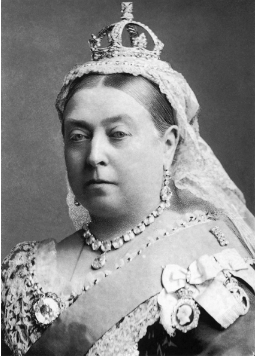
I wonder if Victoria had any idea of the legacy she would leave the world as she first sat on the throne beneath the soaring arches of Westminster Abbey under the gaze of thousands of people. It seemed most of London had thronged the streets well before sunrise on her coronation day hoping to catch a glimpse of their new queen, just eighteen years old and less than five feet tall. As the tiny teenager sat on the throne, her feet not even touching the floor, she would have looked around her and seen the immense abbey filled with aristocrats, their clothing heavy with diamonds. She would have noticed the gold drapes and the exotic carpets, and her neck would have been aching under the heavy crown perched on her head.
When some of us think of Queen Victoria, her amazing heritage may be the first thing we remember. Some may remember the complicated German connection that ran through her veins. Others the tragic failure for her grandchildren to understand one another that destined two great nations to explode on the battlefields during the First World War as the biggest family squabble of all time. And then there’s Albert. So much happened during her complicated reign, it’s hard to pick one issue that didn’t have an impact on society.
What we all agree on is that no one ever imagined that one day Victoria would be the queen. Her father, after all, was not the first son of a king. He was the fourth. This honour was thrust upon her by a succession of unfortunate coincidences including the deaths of family members, two obese uncles with no legitimate children and somehow her father managing to avoid being murdered by mutinous troops and lucky enough to persuade her mother to marry him, despite being a middle-aged bankrupt prince. All of these incidents ultimately left her as the only suitable legitimate candidate to assume the throne and she assumed it incompetently.
Victoria’s tangled connections with the kings, queens and lesser royals of Europe create a strong impression in our minds. It was a somewhat dysfunctional family, one held together largely by arranged marriages between close relatives, some of which turned out to be reasonably happy and many of which certainly did not. With all this interbreeding, ‘difficulties’ inevitably arose.
A hundred years before, Victoria’s Hanoverian ancestors had been offered the throne in the last year of Queen Anne’s life with high hopes of achieving a stable monarchy. What England received was the exact opposite. The family that arrived, and the subsequent descendants, proved to be a fiery, feisty, dysfunctional bunch.
After a relatively short labour of six hours, a roaring, plump baby daughter was born at 4.15 in the morning of May 24th 1819. Within moments, the room was crowded with politicians, clergymen and chancellors, all pressing their ruddy faces close to the bawling baby girl to attest that the child was in fact Victoire and Prince Edward’s. No one wanted the same scandal that James II and his second wife Mary of Modena had suffered. She had delivered a thriving baby boy without the necessary witnesses being present at the birth so the majority of the public (mainly Protestants who disliked Catholic James) believed that she had in fact miscarried yet again and that a live baby had been smuggled into her room in a warming pan to replace the dead child. At that stage, James had been desperate for a male child to succeed him since Mary and Anne were his only surviving children from his first marriage. It was one of the factors that led to the revolution that knocked James II of his throne, so Victoria’s father was very particular that history wasn’t about to repeat itself with his child.
As they stared at the vocal child, no one in the room had any idea that in two decades, they would be bowing to this plump baby and that she would be commanding armies, appointing prime ministers and selecting archbishops. From the moment of her birth, because she was an important child fifth in line to the throne, she would never be alone and every morsel of food would be tested before it reached her lips.
As the sky lightened, her mother lay exhausted in her bed and the tiny child grizzled. The duchess had endured the presence of the men as they peered at the child before they shuffled out of the room murmuring their congratulations to the father and mother, her father full of pride to be the first brother to put a legitimate child in the royal nursery. Despite the unromantic beginnings, they had succeeded when others around them had failed.
Although there was a brief moment when Edward was disappointed at not having a son, the duchess was instantly smitten with her daughter, opting to breastfeed for the first six months while most aristocratic women employed wet nurses. Her peers raised eyebrows, but she continued nursing and Edward watched his stout, pretty daughter grow miraculously.
Victoria blossomed without the use of the wonder drug laudanum, soothed with German lullabies and her father boasted that his chubby daughter with her enormously fat legs was “a pocket Hercules”. While Edward crowed with happiness, his brothers were not so happy. His eldest brother George, who was still grieving for the loss of his only child Charlotte and grandchild on the same day, hated Edward with a passion.
But if Edward thought the hard part was over, it was in for a sad shock. Fate had other ideas.
Victoria’s father had been accumulating enormous debts again, overspending, gambling and living the good life, much like in his bachelor days. So with little money available, he decided to winter modestly away from society beside the seaside in Devon. As an added bonus, doctors had discovered the healing powers of the sea and saltwater baths were highly recommended for nursing mothers. Once again, he borrowed money and the family set off in early December, staying for a short time in Salisbury before arriving on Christmas Eve at Woolbrook Cottage in Devon. Time passed quietly with lazy days idly playing with his daughter, until a rather disconcerting and ominous incident made Edward stop in his tracks. A fortune-teller told him that two members of the Royal Family would die soon and of course Edward was unnerved. It’s not that he took the words of the gypsy too seriously, but with the child mortality rate so high, he was unwilling to take any chances when it came to his precious daughter. Precautions were taken and Victoria was bundled up warmly and cossetted even more than usual. By then Victoria was eight months old but was the size of a 1-year-old with two teeth that had cut through her gums without her even flinching.
As it turned out, it was Edward who caught the cold and in the weeks after Christmas, it worsened. After a fall of heavy snow, Edward and John Conroy took a long walk on the cliffs for some fresh air and Edward returned complaining that the cold made his bones ache. But still there was no cause for alarm.
By 18th January however, his condition had worsened and on the 20th, he took to his bed. Fever and delirium had set in and of course the doctors took over with their gruesome medical treatments. Blistering, bleeding and leeches were administered but not surprisingly, everything failed. During a short respite on 22nd, Edward made a hurried will, making sure that his beloved daughter Drina would be entrusted to the care of her mother.
By evening, a small group had gathered around his bed. He looked at his wife and said, ‘Do not forget me’ and sank once more into delirium. By then, Victoire was anxiously pacing the room and had not changed her clothes or slept much for several days. She would not sleep at all for the next twenty-four hours. At ten o’clock in the morning of 23rd January, Victoria’s father died.
As her uncle King William had hoped, he lived long enough to witness Victoria’s 18th birthday. But only by a whisker. By 4th June, two weeks after her birthday, William’s lungs contained blood, a valve in his heart was closed and his liver and spleen were swollen to twice their size. Barely one month after Victoria’s birthday, William died on 20th June and Victoria moved out of her mother’s bedroom and into the still unfinished Buckingham Palace, far away from her mother with whom she was barely on speaking terms. The presence of John Conroy had become a huge problem for her.
Being incredibly protected by her mother all her life did not leave Victoria shy. On the contrary. She had always known she was meant for the throne of England - there wasn’t anyone else - and knowing that piece of information gave her a certain awareness of her entitlement. It made her self-reliant, impulsive, volatile and it gave her a steely conviction in her own judgement. And of course, she had a Hanoverian temper to go with it that no one had ever thought to teach her to control. As a result, she never learned to accept other authority figures because she was the supreme authority.
The day of her coronation did not go off without incident. Her archbishop jumbled his lines, one of her lords tumbled down the steps when he approached to kiss her hand and she would have noticed her prime minister, half-stoned on opium and drunk on brandy, watching the ceremony in a fog. The ruby coronation ring had even been jammed on the wrong finger and her hand would have been throbbing. Later on, the ring would have to be removed with ice.
Around her she would have noticed her many advisors and none of them would have appeared confident that she could rule a nation as strong and powerful as England. But her composure was impeccable nonetheless. Her voice steady and controlled, and if the thought of becoming a queen terrified her, she gave no sign of it. She never once let on that she was aware of the enormity of the task of becoming Queen at a time when her family had been incredibly unpopular for decades and Britain was still very far from being a democracy.
At a time when the lower class of England needed a diversion desperately from their everyday poverty and hardship, they softened when watching their tiny queen glow with love for Prince Albert of Saxe-Coburg and Gotha. It was the beginning of one of the greatest romances in history.
Despite torrents of rain, violent gusts of wind and extreme cold, people pushed and shoved each other to get a good view of the five-foot bride, dressed beautifully in white satin and lace, a diamond necklace around her neck and glittering diamond earrings in each ear as well as a magnificent sapphire brooch that Albert had given her to adorn her wedding dress. Behind her were twelve trainbearers wearing white dresses adorned with white roses watched on by 300 aristocrats. Beside her walked her cranky old uncle Augustus Duke of Sussex, who gave her away, smiling for once on her wedding day.
Like most marriages, there was a settling in period and there were times when the relationship gears didn’t quite mesh. She loved to stay up late and dance until early in the morning, but Albert had not been raised that way. He wanted to be in bed by ten. More so than in most marriages, there was a thunderous clash of personalities full of terrible rows, slamming doors and fits of shouting echoing through the halls of Buckingham Palace. But after every bitter argument were the heart-felt makeups and in Victoria’s case, her love was almost palpably impassioned.
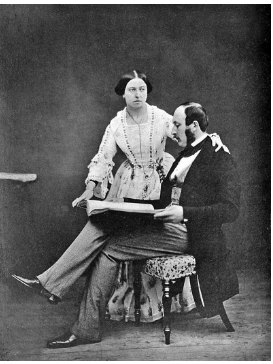
There was no disputing their intense feelings towards each other but the start to the marriage was tempestuous and passionate with neither wanting to surrender their own personal independence and personality. If she was difficult to live with, I think Albert was actually a bit difficult in his own way as well. He could be rather school-masterly, treating Victoria rather like an errant child, which of course she was, and that was like adding fuel to the fire.
But above all else, Albert and Victoria truly and genuinely loved each other and when they were functioning well, they were an amazing pair to behold. Albert came with a lot of emotional baggage because of his family’s dysfunctional history and all he wanted was to be the model husband that his own father wasn’t. To achieve that, they needed to create a fresh image of family values to the expanding middle class. But it came at a price. Albert was more than a little daunted by his role as Consort to his feisty queen and from the very first day, even though she was besotted with her handsome husband, she would not concede any political power to him.
For Victoria, the unfortunate by-product of her obsession with Albert was the arrival of children. And she proved to be a healthy fertile woman. Within weeks of the marriage, she was pregnant. Almost nine months to the day, their first daughter was born and named Victoria, (nicknamed Vicky after her mother) and only months after giving birth, she was annoyed to discover she was pregnant with a second child because pregnancy meant enforced abstinence from nights of married bliss with her ‘angel’ Albert. Because of their vigorous sex life, Albert, Alice, Alfred, Helena, Louise and Arthur soon followed over the space of seven years. Leopold and Beatrice would both be born later in the coming years and with each addition to the growing family, Britain’s memory of her notorious philandering uncles was being purged. But as much as Britain loved Victoria, they saw it as a little odd that she was not the ideal model of motherhood, overheard saying that children were smelly and awkward, with a ‘terrible frog-like action’ and not fit to handle until they were at least six months old. You see, for Victoria, her total attention was focused on Albert.
-->
But for all their sexual harmony, they were locked in a struggle for dominance. Albert had married a queen and Victoria was not shy about reminding him who was in charge. She clung to her power but due to the pregnancies, she was uneasily aware of her inadequacy. As for Albert, he knew exactly what he wanted. He had a desperate need to put his own stamp on British history instead of meekly fitting in with the traditions of the English Royal House and living in the palaces of his wife’s quarrelsome predecessors. He not only wanted control of the royal family but also the royal household and if he was being honest, even the monarchy itself. In his male-dominated childhood, he had little faith in a woman’s ability to rule.
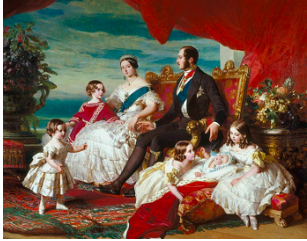
Morally upright in the extreme, Albert was everything his amoral father hadn’t been. He was totally loyal to his wife and he was a ‘hands on’ father, scolding them when he felt it was necessary and punishing them at times rather severely. As a result, the children were in awe of their father and just a little scared of their mother and her fierce tempers. Even Albert was deeply troubled by Victoria’s fierce temper. Always in the back of his mind was the reminder of a particular royal legacy: insanity. And in particular, her grandfather George III. Where most men might confront his wife about her temper, Albert chose the safe ground and walked on eggshells around her, especially during her pregnancies, although sometimes this just made things worse.
Victoria’s terrible rages was not the only problem in the family. Behind the façade of a model family was a hornet’s nest of hostilities with Victoria feeling trapped in her perpetual cycle of pregnancy and children arriving with monotonous regularity. With each new pregnancy, she was forced to relinquish more and more of her political duties to Albert and of course, since he was also trying to be the role-model husband and father, he struggled to balance work and family. He loved his children but he was on his self-created treadmill of work, work, work and duties. And the more Albert worked, the more he was absent, not only from his children, but also from his needy wife. Which created more tension and more rows. Instead of the chocolate box of gorgeousness that everybody was led to believe existed, behind closed doors it was a place riddled with conflict and a cauldron of simmering tension and huge resentments.
Albert was finding his enormous workload exhausting which in turn was affecting his health. He was plagued with neuralgia, fits of shivering, toothache and insomnia. But despite Victoria’s proclaimed adoration for her husband, she had very little sympathy for him. Having given birth to nine children, she thought Albert was just being weak with the inability to endure pain. What she needed was someone she could depend on, not the other way around. And she wasn’t shy about telling him.
And then, disaster struck. On 14th December 1861, Albert died in the Blue Room at Windsor Castle after a short illness and Victoria descended into a crippling state of unrelenting grief.
Usually Windsor Castle came into its own at Christmas. The silence of the Grand Corridor, where noise was muffled by the red carpets and damask curtains, was broken by the happy laughter of children’s voices. Games of hide and seek in the towers and staircases ensued and fires blazed with beech logs in all the reception rooms.
Albert had never been happier than having his family around him. And the year before there was a lot to celebrate. Despite his favourite child, Vicky, resigned to spending Christmas in Germany, isolated from her family, his eldest son Bertie had just returned from an official tour where he had acquitted himself well, thankfully. Alice had met her future husband and all the children were delirious with excitement at the festive season. It was the last Christmas any of them would remember with happiness.
In her intense grief, Victoria withdrew from the public eye and lost interest in all political matters. She could barely function as a human being let alone as a monarch. Where once her palaces were places of laughter and happiness, they had turned into mausoleums.
Victoria grieved for over 40 years until her death in 1901 and everyone knew that her passing meant the end of an era. The grandmother of Europe, who held the extended royal family together, was dead and no one believed her son Bertie could possibly fill her shoes. For hundreds of thousands of people throughout the world, Queen Victoria had become something more than simply a caustic, selfish old lady in a bonnet. Sure they knew she could be dismissive, obstinate and prone to self-pity. And yes, millions died of starvation and disease during her reign and she seemed blind to their plight. She could be demanding, rude and frequently fled public duties for the peace and solitude of Scotland. She even formed attachments to her servants that were so strong they were considered peculiar and even suspect.
But she had loved fiercely, despised racial and religious prejudice and had survived six assignation attempts. She had surpassed autocracy and had become the role model for all future successful constitutional monarchs, as well as a beloved figurehead. Under her reign, England had achieved a greatness it had never known before. This queen with the stern profile, clothed in her reams of black mourning cloth, would forever be associated with growth, might and democracy. Her legacy was enormous: an empire, nine children, forty-two grandchildren and the longest-reigning monarch in English history to date. Our Queen Elizabeth has surpassed her in this regard.
Victoria safeguarded the British people as they took steps towards democracy in a century full of unrest. She may have done it as a mother, who followed her husband from room to room while they fought, storming, yelling and crying, and she may have done it while she tried to resolve her depression and overwhelming prolonged grief. But she had done it. Her story was one of a tiny, strong woman at the heart of an empire and without her, a chilly uncertain new century was dawning.
Two days after her death, Kaiser Wilhelm rode side by side with his old sailing rival, now King Edward VII, behind Victoria’s coffin: uncle and nephew united in grief.
In Germany, there were howls of fury.
Victoria to VikingsThe Circle of Blood
 At the heart of our present are the stories of our past. In ages gone by, many monarchs died while they were still young. There were battles and diseases and many were simply overthrown. But the days of regal engagement in hand-to-hand combat are over and the line of succession has a good ageing prospect these days.
At the heart of our present are the stories of our past. In ages gone by, many monarchs died while they were still young. There were battles and diseases and many were simply overthrown. But the days of regal engagement in hand-to-hand combat are over and the line of succession has a good ageing prospect these days.
One of the most famous monarchs in history is Queen Victoria and her passing brought an end to an amazing era. She could be demanding, rude and she frequently fled public duties for the solitude of Scotland. But she loved fiercely and her people loved her fiercely in return. Under her reign, England achieved a greatness it had never known before.
Victoria to Vikings: The Circle of Blood spans from this great queen to another one: Queen Elizabeth II. Ours is the era of the longest living monarch in history and her ancestry is incredible. But walking two steps behind her, stalwart and loyal, stands Prince Philip, the strawberry to her champagne, and with him comes his own amazing Viking heritage.
Pre-order up your copy ofVictoria to VikingsThe Circle of BloodReleased May 28th, 2019
Amazon UK • Amazon US
Vikings to Virgin:The Hazards of Being King
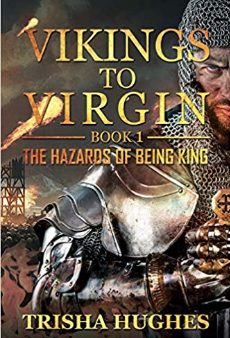
In Vikings to Virgin - The Hazards of Being King Trisha Hughes provides the reader with a pacey introduction to the many pitfalls faced by the ambitious as they climbed the dangerous ladders of royalty. It is easy to think that monarchs are all powerful, but throughout the Dark and Middle Ages it was surprisingly easy to unseat one and assume the crown yourself. But if it was easy to gain ... it was just as easy to lose.From the dawn of the Vikings through to Elizabeth I, Trisha Hughes follows the violent struggles for power and the many brutal methods employed to wrest it and keep hold of it. Murder, deceit, treachery, lust and betrayal were just a few of the methods used to try and win the crown. Vikings to Virgin - The Hazards of Being King spans fifteen hundred years and is a highly accessible and enjoyable ride through the dark side of early British monarchy.
Amazon UK • Amazon US
Virgin to Victoria
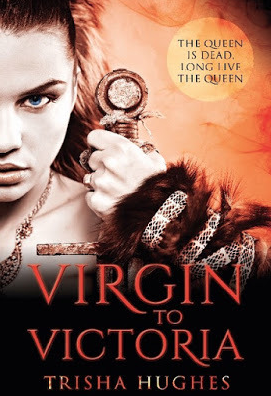 Virgin to Victoria is a powerful retelling of the history of the British monarchy, beginning with Henry VIII's daughter, Elizabeth I, as she comes to the throne. Charting Elizabeth's incredible journey, Virgin to Victoria travels in time through the confusion of the Stuart dynasty, the devastation of a Civil War led by Oliver Cromwell, horrific battles for the throne and the turbulent Hanover dynasty with its intricate family squabbles. Despite her amazing legacy, Elizabeth failed England in one vital area. She never married, nor did she leave an heir to the Tudor family. In making this one fateful decision, the Virgin Queen left the path open for a take-over and life would never be the same. Victoria did not ask to be Queen. It was thrust upon her by a series of events that removed all others who stood in line for the throne. She assumed it reluctantly and, at first, incompetently. Parliament was sure that the 18-year-old could be relied upon to leave the job of running the country to the professionals. Couldn't she?
Virgin to Victoria is a powerful retelling of the history of the British monarchy, beginning with Henry VIII's daughter, Elizabeth I, as she comes to the throne. Charting Elizabeth's incredible journey, Virgin to Victoria travels in time through the confusion of the Stuart dynasty, the devastation of a Civil War led by Oliver Cromwell, horrific battles for the throne and the turbulent Hanover dynasty with its intricate family squabbles. Despite her amazing legacy, Elizabeth failed England in one vital area. She never married, nor did she leave an heir to the Tudor family. In making this one fateful decision, the Virgin Queen left the path open for a take-over and life would never be the same. Victoria did not ask to be Queen. It was thrust upon her by a series of events that removed all others who stood in line for the throne. She assumed it reluctantly and, at first, incompetently. Parliament was sure that the 18-year-old could be relied upon to leave the job of running the country to the professionals. Couldn't she?
Amazon UK • Amazon US
Trisha Hughes
 I was born in a little outback town called Blackall in Central Queensland, Australia. From there my parents moved to the Brisbane suburb of Fortitude Valley where I grew up to be a tiny, self-reliant little girl.
I was born in a little outback town called Blackall in Central Queensland, Australia. From there my parents moved to the Brisbane suburb of Fortitude Valley where I grew up to be a tiny, self-reliant little girl.
My first book, ‘Daughters of Nazareth’ is my story, written eighteen years ago, fuelled on by the discovery of a family I never knew I had. It’s full of family secrets, tremendous heartache but proves the human spirit’s amazing ability to triumph over adversity. Nineteen years ago, after just one phone call, my life changed abruptly. With that change came a passion for writing and I have been writing ever since.
I love writing crime novels but my passion is with the history of the British Monarchy. The first in my ‘V2V’ trilogy is ‘Vikings to Virgin – The Hazards of being King ’ published in 2017. The second in the series is due for release on 28th April this year and is called ‘Virgin to Victoria – The Queen is Dead. Long live the Queen.’ The final book, ‘Victoria to Vikings – The Circle of Blood’ will be released early 2019.
Trisha loves to hear from readers, you can find her: Website • Twitter • Facebook

I wonder if Victoria had any idea of the legacy she would leave the world as she first sat on the throne beneath the soaring arches of Westminster Abbey under the gaze of thousands of people. It seemed most of London had thronged the streets well before sunrise on her coronation day hoping to catch a glimpse of their new queen, just eighteen years old and less than five feet tall. As the tiny teenager sat on the throne, her feet not even touching the floor, she would have looked around her and seen the immense abbey filled with aristocrats, their clothing heavy with diamonds. She would have noticed the gold drapes and the exotic carpets, and her neck would have been aching under the heavy crown perched on her head.
When some of us think of Queen Victoria, her amazing heritage may be the first thing we remember. Some may remember the complicated German connection that ran through her veins. Others the tragic failure for her grandchildren to understand one another that destined two great nations to explode on the battlefields during the First World War as the biggest family squabble of all time. And then there’s Albert. So much happened during her complicated reign, it’s hard to pick one issue that didn’t have an impact on society.
What we all agree on is that no one ever imagined that one day Victoria would be the queen. Her father, after all, was not the first son of a king. He was the fourth. This honour was thrust upon her by a succession of unfortunate coincidences including the deaths of family members, two obese uncles with no legitimate children and somehow her father managing to avoid being murdered by mutinous troops and lucky enough to persuade her mother to marry him, despite being a middle-aged bankrupt prince. All of these incidents ultimately left her as the only suitable legitimate candidate to assume the throne and she assumed it incompetently.
Victoria’s tangled connections with the kings, queens and lesser royals of Europe create a strong impression in our minds. It was a somewhat dysfunctional family, one held together largely by arranged marriages between close relatives, some of which turned out to be reasonably happy and many of which certainly did not. With all this interbreeding, ‘difficulties’ inevitably arose.
A hundred years before, Victoria’s Hanoverian ancestors had been offered the throne in the last year of Queen Anne’s life with high hopes of achieving a stable monarchy. What England received was the exact opposite. The family that arrived, and the subsequent descendants, proved to be a fiery, feisty, dysfunctional bunch.
After a relatively short labour of six hours, a roaring, plump baby daughter was born at 4.15 in the morning of May 24th 1819. Within moments, the room was crowded with politicians, clergymen and chancellors, all pressing their ruddy faces close to the bawling baby girl to attest that the child was in fact Victoire and Prince Edward’s. No one wanted the same scandal that James II and his second wife Mary of Modena had suffered. She had delivered a thriving baby boy without the necessary witnesses being present at the birth so the majority of the public (mainly Protestants who disliked Catholic James) believed that she had in fact miscarried yet again and that a live baby had been smuggled into her room in a warming pan to replace the dead child. At that stage, James had been desperate for a male child to succeed him since Mary and Anne were his only surviving children from his first marriage. It was one of the factors that led to the revolution that knocked James II of his throne, so Victoria’s father was very particular that history wasn’t about to repeat itself with his child.
As they stared at the vocal child, no one in the room had any idea that in two decades, they would be bowing to this plump baby and that she would be commanding armies, appointing prime ministers and selecting archbishops. From the moment of her birth, because she was an important child fifth in line to the throne, she would never be alone and every morsel of food would be tested before it reached her lips.
As the sky lightened, her mother lay exhausted in her bed and the tiny child grizzled. The duchess had endured the presence of the men as they peered at the child before they shuffled out of the room murmuring their congratulations to the father and mother, her father full of pride to be the first brother to put a legitimate child in the royal nursery. Despite the unromantic beginnings, they had succeeded when others around them had failed.
Although there was a brief moment when Edward was disappointed at not having a son, the duchess was instantly smitten with her daughter, opting to breastfeed for the first six months while most aristocratic women employed wet nurses. Her peers raised eyebrows, but she continued nursing and Edward watched his stout, pretty daughter grow miraculously.
Victoria blossomed without the use of the wonder drug laudanum, soothed with German lullabies and her father boasted that his chubby daughter with her enormously fat legs was “a pocket Hercules”. While Edward crowed with happiness, his brothers were not so happy. His eldest brother George, who was still grieving for the loss of his only child Charlotte and grandchild on the same day, hated Edward with a passion.
But if Edward thought the hard part was over, it was in for a sad shock. Fate had other ideas.
Victoria’s father had been accumulating enormous debts again, overspending, gambling and living the good life, much like in his bachelor days. So with little money available, he decided to winter modestly away from society beside the seaside in Devon. As an added bonus, doctors had discovered the healing powers of the sea and saltwater baths were highly recommended for nursing mothers. Once again, he borrowed money and the family set off in early December, staying for a short time in Salisbury before arriving on Christmas Eve at Woolbrook Cottage in Devon. Time passed quietly with lazy days idly playing with his daughter, until a rather disconcerting and ominous incident made Edward stop in his tracks. A fortune-teller told him that two members of the Royal Family would die soon and of course Edward was unnerved. It’s not that he took the words of the gypsy too seriously, but with the child mortality rate so high, he was unwilling to take any chances when it came to his precious daughter. Precautions were taken and Victoria was bundled up warmly and cossetted even more than usual. By then Victoria was eight months old but was the size of a 1-year-old with two teeth that had cut through her gums without her even flinching.
As it turned out, it was Edward who caught the cold and in the weeks after Christmas, it worsened. After a fall of heavy snow, Edward and John Conroy took a long walk on the cliffs for some fresh air and Edward returned complaining that the cold made his bones ache. But still there was no cause for alarm.
By 18th January however, his condition had worsened and on the 20th, he took to his bed. Fever and delirium had set in and of course the doctors took over with their gruesome medical treatments. Blistering, bleeding and leeches were administered but not surprisingly, everything failed. During a short respite on 22nd, Edward made a hurried will, making sure that his beloved daughter Drina would be entrusted to the care of her mother.
By evening, a small group had gathered around his bed. He looked at his wife and said, ‘Do not forget me’ and sank once more into delirium. By then, Victoire was anxiously pacing the room and had not changed her clothes or slept much for several days. She would not sleep at all for the next twenty-four hours. At ten o’clock in the morning of 23rd January, Victoria’s father died.
As her uncle King William had hoped, he lived long enough to witness Victoria’s 18th birthday. But only by a whisker. By 4th June, two weeks after her birthday, William’s lungs contained blood, a valve in his heart was closed and his liver and spleen were swollen to twice their size. Barely one month after Victoria’s birthday, William died on 20th June and Victoria moved out of her mother’s bedroom and into the still unfinished Buckingham Palace, far away from her mother with whom she was barely on speaking terms. The presence of John Conroy had become a huge problem for her.
Being incredibly protected by her mother all her life did not leave Victoria shy. On the contrary. She had always known she was meant for the throne of England - there wasn’t anyone else - and knowing that piece of information gave her a certain awareness of her entitlement. It made her self-reliant, impulsive, volatile and it gave her a steely conviction in her own judgement. And of course, she had a Hanoverian temper to go with it that no one had ever thought to teach her to control. As a result, she never learned to accept other authority figures because she was the supreme authority.
The day of her coronation did not go off without incident. Her archbishop jumbled his lines, one of her lords tumbled down the steps when he approached to kiss her hand and she would have noticed her prime minister, half-stoned on opium and drunk on brandy, watching the ceremony in a fog. The ruby coronation ring had even been jammed on the wrong finger and her hand would have been throbbing. Later on, the ring would have to be removed with ice.
Around her she would have noticed her many advisors and none of them would have appeared confident that she could rule a nation as strong and powerful as England. But her composure was impeccable nonetheless. Her voice steady and controlled, and if the thought of becoming a queen terrified her, she gave no sign of it. She never once let on that she was aware of the enormity of the task of becoming Queen at a time when her family had been incredibly unpopular for decades and Britain was still very far from being a democracy.
At a time when the lower class of England needed a diversion desperately from their everyday poverty and hardship, they softened when watching their tiny queen glow with love for Prince Albert of Saxe-Coburg and Gotha. It was the beginning of one of the greatest romances in history.
Despite torrents of rain, violent gusts of wind and extreme cold, people pushed and shoved each other to get a good view of the five-foot bride, dressed beautifully in white satin and lace, a diamond necklace around her neck and glittering diamond earrings in each ear as well as a magnificent sapphire brooch that Albert had given her to adorn her wedding dress. Behind her were twelve trainbearers wearing white dresses adorned with white roses watched on by 300 aristocrats. Beside her walked her cranky old uncle Augustus Duke of Sussex, who gave her away, smiling for once on her wedding day.
Like most marriages, there was a settling in period and there were times when the relationship gears didn’t quite mesh. She loved to stay up late and dance until early in the morning, but Albert had not been raised that way. He wanted to be in bed by ten. More so than in most marriages, there was a thunderous clash of personalities full of terrible rows, slamming doors and fits of shouting echoing through the halls of Buckingham Palace. But after every bitter argument were the heart-felt makeups and in Victoria’s case, her love was almost palpably impassioned.

There was no disputing their intense feelings towards each other but the start to the marriage was tempestuous and passionate with neither wanting to surrender their own personal independence and personality. If she was difficult to live with, I think Albert was actually a bit difficult in his own way as well. He could be rather school-masterly, treating Victoria rather like an errant child, which of course she was, and that was like adding fuel to the fire.
But above all else, Albert and Victoria truly and genuinely loved each other and when they were functioning well, they were an amazing pair to behold. Albert came with a lot of emotional baggage because of his family’s dysfunctional history and all he wanted was to be the model husband that his own father wasn’t. To achieve that, they needed to create a fresh image of family values to the expanding middle class. But it came at a price. Albert was more than a little daunted by his role as Consort to his feisty queen and from the very first day, even though she was besotted with her handsome husband, she would not concede any political power to him.
For Victoria, the unfortunate by-product of her obsession with Albert was the arrival of children. And she proved to be a healthy fertile woman. Within weeks of the marriage, she was pregnant. Almost nine months to the day, their first daughter was born and named Victoria, (nicknamed Vicky after her mother) and only months after giving birth, she was annoyed to discover she was pregnant with a second child because pregnancy meant enforced abstinence from nights of married bliss with her ‘angel’ Albert. Because of their vigorous sex life, Albert, Alice, Alfred, Helena, Louise and Arthur soon followed over the space of seven years. Leopold and Beatrice would both be born later in the coming years and with each addition to the growing family, Britain’s memory of her notorious philandering uncles was being purged. But as much as Britain loved Victoria, they saw it as a little odd that she was not the ideal model of motherhood, overheard saying that children were smelly and awkward, with a ‘terrible frog-like action’ and not fit to handle until they were at least six months old. You see, for Victoria, her total attention was focused on Albert.
-->
But for all their sexual harmony, they were locked in a struggle for dominance. Albert had married a queen and Victoria was not shy about reminding him who was in charge. She clung to her power but due to the pregnancies, she was uneasily aware of her inadequacy. As for Albert, he knew exactly what he wanted. He had a desperate need to put his own stamp on British history instead of meekly fitting in with the traditions of the English Royal House and living in the palaces of his wife’s quarrelsome predecessors. He not only wanted control of the royal family but also the royal household and if he was being honest, even the monarchy itself. In his male-dominated childhood, he had little faith in a woman’s ability to rule.

Morally upright in the extreme, Albert was everything his amoral father hadn’t been. He was totally loyal to his wife and he was a ‘hands on’ father, scolding them when he felt it was necessary and punishing them at times rather severely. As a result, the children were in awe of their father and just a little scared of their mother and her fierce tempers. Even Albert was deeply troubled by Victoria’s fierce temper. Always in the back of his mind was the reminder of a particular royal legacy: insanity. And in particular, her grandfather George III. Where most men might confront his wife about her temper, Albert chose the safe ground and walked on eggshells around her, especially during her pregnancies, although sometimes this just made things worse.
Victoria’s terrible rages was not the only problem in the family. Behind the façade of a model family was a hornet’s nest of hostilities with Victoria feeling trapped in her perpetual cycle of pregnancy and children arriving with monotonous regularity. With each new pregnancy, she was forced to relinquish more and more of her political duties to Albert and of course, since he was also trying to be the role-model husband and father, he struggled to balance work and family. He loved his children but he was on his self-created treadmill of work, work, work and duties. And the more Albert worked, the more he was absent, not only from his children, but also from his needy wife. Which created more tension and more rows. Instead of the chocolate box of gorgeousness that everybody was led to believe existed, behind closed doors it was a place riddled with conflict and a cauldron of simmering tension and huge resentments.
Albert was finding his enormous workload exhausting which in turn was affecting his health. He was plagued with neuralgia, fits of shivering, toothache and insomnia. But despite Victoria’s proclaimed adoration for her husband, she had very little sympathy for him. Having given birth to nine children, she thought Albert was just being weak with the inability to endure pain. What she needed was someone she could depend on, not the other way around. And she wasn’t shy about telling him.
And then, disaster struck. On 14th December 1861, Albert died in the Blue Room at Windsor Castle after a short illness and Victoria descended into a crippling state of unrelenting grief.
Usually Windsor Castle came into its own at Christmas. The silence of the Grand Corridor, where noise was muffled by the red carpets and damask curtains, was broken by the happy laughter of children’s voices. Games of hide and seek in the towers and staircases ensued and fires blazed with beech logs in all the reception rooms.
Albert had never been happier than having his family around him. And the year before there was a lot to celebrate. Despite his favourite child, Vicky, resigned to spending Christmas in Germany, isolated from her family, his eldest son Bertie had just returned from an official tour where he had acquitted himself well, thankfully. Alice had met her future husband and all the children were delirious with excitement at the festive season. It was the last Christmas any of them would remember with happiness.
In her intense grief, Victoria withdrew from the public eye and lost interest in all political matters. She could barely function as a human being let alone as a monarch. Where once her palaces were places of laughter and happiness, they had turned into mausoleums.
Victoria grieved for over 40 years until her death in 1901 and everyone knew that her passing meant the end of an era. The grandmother of Europe, who held the extended royal family together, was dead and no one believed her son Bertie could possibly fill her shoes. For hundreds of thousands of people throughout the world, Queen Victoria had become something more than simply a caustic, selfish old lady in a bonnet. Sure they knew she could be dismissive, obstinate and prone to self-pity. And yes, millions died of starvation and disease during her reign and she seemed blind to their plight. She could be demanding, rude and frequently fled public duties for the peace and solitude of Scotland. She even formed attachments to her servants that were so strong they were considered peculiar and even suspect.
But she had loved fiercely, despised racial and religious prejudice and had survived six assignation attempts. She had surpassed autocracy and had become the role model for all future successful constitutional monarchs, as well as a beloved figurehead. Under her reign, England had achieved a greatness it had never known before. This queen with the stern profile, clothed in her reams of black mourning cloth, would forever be associated with growth, might and democracy. Her legacy was enormous: an empire, nine children, forty-two grandchildren and the longest-reigning monarch in English history to date. Our Queen Elizabeth has surpassed her in this regard.
Victoria safeguarded the British people as they took steps towards democracy in a century full of unrest. She may have done it as a mother, who followed her husband from room to room while they fought, storming, yelling and crying, and she may have done it while she tried to resolve her depression and overwhelming prolonged grief. But she had done it. Her story was one of a tiny, strong woman at the heart of an empire and without her, a chilly uncertain new century was dawning.
Two days after her death, Kaiser Wilhelm rode side by side with his old sailing rival, now King Edward VII, behind Victoria’s coffin: uncle and nephew united in grief.
In Germany, there were howls of fury.
Victoria to VikingsThe Circle of Blood
 At the heart of our present are the stories of our past. In ages gone by, many monarchs died while they were still young. There were battles and diseases and many were simply overthrown. But the days of regal engagement in hand-to-hand combat are over and the line of succession has a good ageing prospect these days.
At the heart of our present are the stories of our past. In ages gone by, many monarchs died while they were still young. There were battles and diseases and many were simply overthrown. But the days of regal engagement in hand-to-hand combat are over and the line of succession has a good ageing prospect these days.One of the most famous monarchs in history is Queen Victoria and her passing brought an end to an amazing era. She could be demanding, rude and she frequently fled public duties for the solitude of Scotland. But she loved fiercely and her people loved her fiercely in return. Under her reign, England achieved a greatness it had never known before.
Victoria to Vikings: The Circle of Blood spans from this great queen to another one: Queen Elizabeth II. Ours is the era of the longest living monarch in history and her ancestry is incredible. But walking two steps behind her, stalwart and loyal, stands Prince Philip, the strawberry to her champagne, and with him comes his own amazing Viking heritage.
Pre-order up your copy ofVictoria to VikingsThe Circle of BloodReleased May 28th, 2019
Amazon UK • Amazon US
Vikings to Virgin:The Hazards of Being King

In Vikings to Virgin - The Hazards of Being King Trisha Hughes provides the reader with a pacey introduction to the many pitfalls faced by the ambitious as they climbed the dangerous ladders of royalty. It is easy to think that monarchs are all powerful, but throughout the Dark and Middle Ages it was surprisingly easy to unseat one and assume the crown yourself. But if it was easy to gain ... it was just as easy to lose.From the dawn of the Vikings through to Elizabeth I, Trisha Hughes follows the violent struggles for power and the many brutal methods employed to wrest it and keep hold of it. Murder, deceit, treachery, lust and betrayal were just a few of the methods used to try and win the crown. Vikings to Virgin - The Hazards of Being King spans fifteen hundred years and is a highly accessible and enjoyable ride through the dark side of early British monarchy.
Amazon UK • Amazon US
Virgin to Victoria
 Virgin to Victoria is a powerful retelling of the history of the British monarchy, beginning with Henry VIII's daughter, Elizabeth I, as she comes to the throne. Charting Elizabeth's incredible journey, Virgin to Victoria travels in time through the confusion of the Stuart dynasty, the devastation of a Civil War led by Oliver Cromwell, horrific battles for the throne and the turbulent Hanover dynasty with its intricate family squabbles. Despite her amazing legacy, Elizabeth failed England in one vital area. She never married, nor did she leave an heir to the Tudor family. In making this one fateful decision, the Virgin Queen left the path open for a take-over and life would never be the same. Victoria did not ask to be Queen. It was thrust upon her by a series of events that removed all others who stood in line for the throne. She assumed it reluctantly and, at first, incompetently. Parliament was sure that the 18-year-old could be relied upon to leave the job of running the country to the professionals. Couldn't she?
Virgin to Victoria is a powerful retelling of the history of the British monarchy, beginning with Henry VIII's daughter, Elizabeth I, as she comes to the throne. Charting Elizabeth's incredible journey, Virgin to Victoria travels in time through the confusion of the Stuart dynasty, the devastation of a Civil War led by Oliver Cromwell, horrific battles for the throne and the turbulent Hanover dynasty with its intricate family squabbles. Despite her amazing legacy, Elizabeth failed England in one vital area. She never married, nor did she leave an heir to the Tudor family. In making this one fateful decision, the Virgin Queen left the path open for a take-over and life would never be the same. Victoria did not ask to be Queen. It was thrust upon her by a series of events that removed all others who stood in line for the throne. She assumed it reluctantly and, at first, incompetently. Parliament was sure that the 18-year-old could be relied upon to leave the job of running the country to the professionals. Couldn't she?Amazon UK • Amazon US
Trisha Hughes
 I was born in a little outback town called Blackall in Central Queensland, Australia. From there my parents moved to the Brisbane suburb of Fortitude Valley where I grew up to be a tiny, self-reliant little girl.
I was born in a little outback town called Blackall in Central Queensland, Australia. From there my parents moved to the Brisbane suburb of Fortitude Valley where I grew up to be a tiny, self-reliant little girl.My first book, ‘Daughters of Nazareth’ is my story, written eighteen years ago, fuelled on by the discovery of a family I never knew I had. It’s full of family secrets, tremendous heartache but proves the human spirit’s amazing ability to triumph over adversity. Nineteen years ago, after just one phone call, my life changed abruptly. With that change came a passion for writing and I have been writing ever since.
I love writing crime novels but my passion is with the history of the British Monarchy. The first in my ‘V2V’ trilogy is ‘Vikings to Virgin – The Hazards of being King ’ published in 2017. The second in the series is due for release on 28th April this year and is called ‘Virgin to Victoria – The Queen is Dead. Long live the Queen.’ The final book, ‘Victoria to Vikings – The Circle of Blood’ will be released early 2019.
Trisha loves to hear from readers, you can find her: Website • Twitter • Facebook
Published on May 23, 2019 23:00
Author, Mary Ann Bernal is asking the question — Was Vlad the Impaler the “real” Count Dracula? #Vampires #History @BritonandDane
Was Vlad the Impaler the “real” Count Dracula?By Mary Ann Bernal
 Whitby Abbey.
Whitby Abbey.The answer is obvious, isn’t it? The formidable Vlad the Impaler is the person Bram Stoker thought of when creating his Dracula persona, meant to scare young and old alike.
 Vlad III — Wikipedia.
Vlad III — Wikipedia.Briefly, Vlad III was a nobleman from the House of Draculesti (Volvode (Baron) Dracula) whose father ruled Wallachia (Romania) until his murder during a Hungarian invasion. As a young man, Vlad witnessed the atrocities of warfare, which awakened his psychopathic tendencies. His bloodlust was left unchecked and impaling his prisoners was his favorite method of execution.
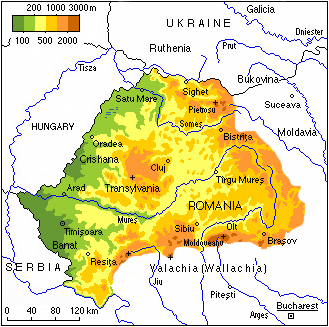
Vlad did invade Transylvania (Central Romania) with its own Dacian mythology. There is a wealth of inspiration stemming from this wide range of myths and legends. Focusing on immortality; gods and animals were worshipped but it was the wolf cult that created the werewolf. The vampire belief originates from Sumerian, Assyrian and Jewish mythologies.And here we have it, all in one place, enough folklore to fill a library with scary novels.
Let’s go back a bit further to ancient Mesopotamia where there is mention of Lilith, a possible vampire, who hunted newborn children at night. The ancient Greeks believed in monsters who ate children and drank their blood. Ancient China’s vampire monsters were called the kiang shi. There are vampire stories from ancient India and Nepal. Ancient Nepalese cave paintings show a man holding a blood-filled human skull goblet while standing in a pool of blood. Malayan monsters lived by drinking the blood of infants. Mexico feared vampires into the sixteenth century when the Spanish Conquistadors conquered the country. Ancient Peru also believed in devil worshipers who sucked the blood of infants, and even in Africa, there was the belief that the dead returned and lived again off the blood of the living.

Truth be told, people from days of old received information via word of mouth, keeping the tales alive, and in all likelihood, the narratives were embellished over time, but they did believe the stories and sought remedies to protect themselves from the devil! Who else could control the paranormal creatures roaming the earth in search of human prey? In all of Christendom, it was the devil that was feared the most because he coveted human souls.
 Killing Vampires kit — Wikipedia.
Killing Vampires kit — Wikipedia.We all know how to keep vampires at bay, never invite them into one’s house. Of course, that means never leaving home and that is just not practical. What about using garlic? The theory being vampires are allergic to the chemical composition of the vegetable. What about crosses? Christianity was widespread with Christ’s cross being a symbol to ward off evil, and vampires were pure evil. And let’s not forget sunlight – remember, vampires are cursed and their skin will burn. Another choice is the wooden stake through the vampire’s heart, which would be done during the day when the vampire is sleeping. Ridiculous, you say? There are no such things. Right? Not so fast. In Bulgaria, a few years ago, archeologists unearthed a gravesite where people were buried with metal stakes through their hearts, which would have kept them from joining the ranks of the undead.
 Erythropoietic protoporphyria (EPP) — Wikipedia.
Erythropoietic protoporphyria (EPP) — Wikipedia.There is a blood disorder, Erythropoietic protoporphyria (EPP), that can cause painful blisters in children suffering from the disorder when exposed to sunlight. Also, the child generally appears tired and pale. Could this condition be the reason for the sunlight “cure” to kill a vampire?
Unfortunately, superstitions continue to flourish in the modern era. A few years ago, in Malawi (Africa), an angry mob killed eight accused “vampires”. The police arrested the perpetrators, charging them with murder.

Bram Stoker would have had ample examples to choose from while creating his Dacula character, but did he bother to extensively research the topic before writing his story? Irving Stoker has stated his father’s Dracula was a figment of his father’s imagination and nothing more. Since we cannot ask the author himself, the answer is pure conjecture. Was it because Vlad the Impaler has been compared to Caligula and Nero as being one of the worst sadistic psychopathic rulers of the day that has fostered the myth? You decide.
Scribbler Tales (Volume Four)“Cunning.”

Newlywed Charlotte von Lichtner is obsessed with Transylvanian folklore when she encounters her husband’s mysterious kinsman.
Excerpt
“Try not to get into any trouble while I’m gone,” Frederick replied with a devilish grin as he left the room.
Walking towards the window, Charlotte pulled back the drapes and admired the breathtaking view, which overlooked the quaint village nestled in the valley. A howling sound made the hairs on the nape of her neck stand up because it appeared to be inhuman, reminding her of The Hound of the Baskervilles.
There’s nothing supernatural here. You really need to control your imagination, Charlotte thought. It was the wind.
Pick up your copy of
Scribbler Tales (Volume Four)
Amazon UK • Amazon US
Mary Ann Bernal
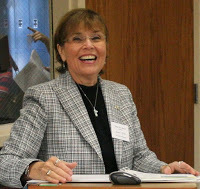 Mary Ann Bernal attended Mercy College, Dobbs Ferry, NY, where she received a degree in Business Administration. Her literary aspirations were ultimately realized when the first book of The Briton and the Dane novels was published in 2009. In addition to writing historical fiction, Mary Ann has also authored a collection of contemporary short stories in the Scribbler Tales series. Her latest endeavor is a science fiction/fantasy novel entitled Planetary Wars Rise of an Empire. Originally hailing from New York, Mary Ann now resides in Elkhorn, Nebraska.
Mary Ann Bernal attended Mercy College, Dobbs Ferry, NY, where she received a degree in Business Administration. Her literary aspirations were ultimately realized when the first book of The Briton and the Dane novels was published in 2009. In addition to writing historical fiction, Mary Ann has also authored a collection of contemporary short stories in the Scribbler Tales series. Her latest endeavor is a science fiction/fantasy novel entitled Planetary Wars Rise of an Empire. Originally hailing from New York, Mary Ann now resides in Elkhorn, Nebraska.Connect with Mary Ann: Website • Blog • Facebook • Twitter • Pinterest
Published on May 23, 2019 22:00
Join me in conversation with #HistoricalFiction author, Mary D. Brooks. Mary is also giving away 3 ebook copies of her fabulous book — In The Blood Of The Greeks @MaryDBrooksFic
What inspired you to write In the Blood of the Greeks?
This is a long, roundabout way of explaining “Enemy at the Gate” novella from The Darkest Hour anthology.
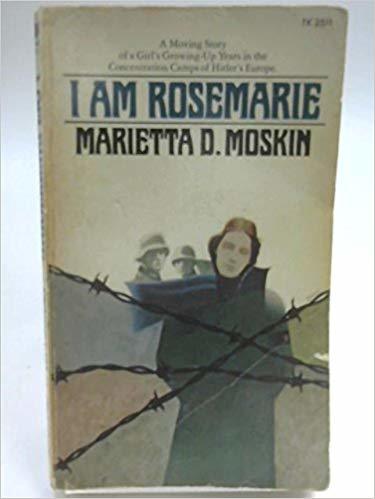
When I was 10 years old, we moved into a home next to an old lady (what I assumed was old…everyone was old to my 10 year old eyes). The woman would become my adopted grandmother. She was an Auschwitz survivor and I spent quite some time with her after school. At 14 years of age, she gave me my first Holocaust novel because I didn’t have a clue what the Holocaust was. The book is called “I Am Rosemarie” by Marietta D. Moskin. It changed my view of the world and increased my desire to find out all that I can. As it happened when I was 14 we went on a trip to Greece and I met my grandfather. We spent the afternoons on his rooftop with the homing pigeons and his stories of the German / Italian occupation of his town. He told me stories of the Greek Resistance and how he took part.
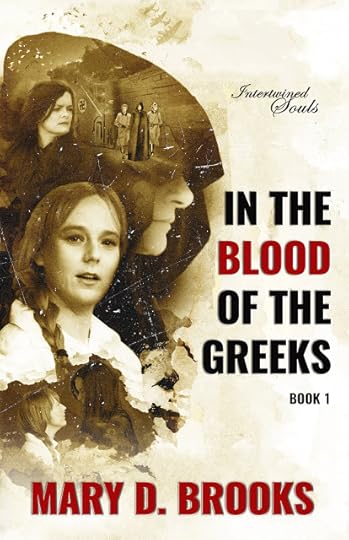
The idea to bring those two elements together in a novel began to take shape. It wasn’t until my grandfather died – well into my thirties – did I come back to the idea and began to research and develop the storyline. That idea gave birth to my first novel “In The Blood of the Greeks”. The character of Zoe Lambros is one that begs to be written about (and she doesn’t shut up so I have to write about her).
Enemy at the Gate is her coming of age story as a Greek resistance member. In the Blood of the Greeks picks up the story 2 years into the German occupation.
Enemy at the Gate is at the beginning and tells the first year of the occupation through Zoe’s eyes.
Enemy at the Gate is such a marvellous novella. You can read The Coffee Pot Book Club Book Review HERE!What were the challenges you faced in researching this period of history?
Getting EVERYTHING historically accurate as possible was the biggest challenge. I love research so that part was not a chore. I’m a history nerd so delving into WW2 Greece was manna from heaven. While the subject matter can get dark and emotional, telling the story that is historically accurate is paramount. I set about finding various different sources for each historical fact I want to introduce.
Your research certainly paid off. There are many books about WW2. Can you tell us three things that set your novel apart?
It’s set in Greece. Not many WW2 novels are set there so it’s a different locale.
It’s got Zoe Lambros. A force of nature and I have NO idea where she came from but she’s here to stay, living rent free in my head and on paper/screen. She’s quite an addiction.
Stories involving strong female Greek Resistance members.
One last question. Can you tell us what are you currently working on?
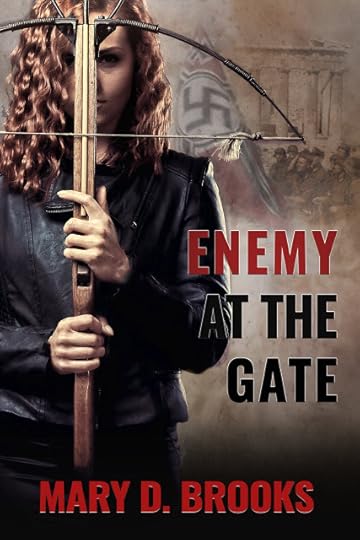
I’m turning the novella “Enemy at the Gate” into a novel by adding details and additional chapters which didn’t make it into the novella due to length constraints.
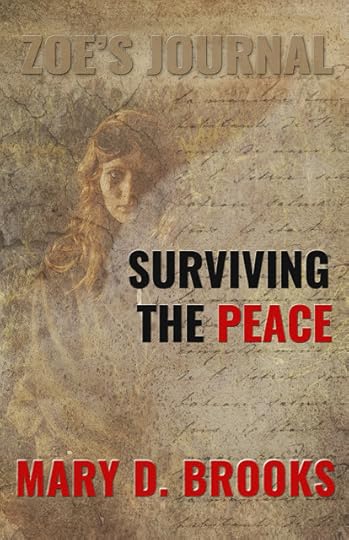
I’m writing Surviving The Peace – my characters of Eva & Zoe are at the end of the war on the mainland (Greece) but must escape the country before Civil War breaks out. They head for Crete on one final Resistance mission with the Germans still occupying the island.
I’m in the planning stages of a prequel and concentrating on Eva Muller’s backstory and setting that in Paris in 1941 when she decides to collaborate with the French Resistance against her Nazi father. That’s called “Resistance in the Shadows”
I am so excited that you are turning Enemy at the Gate into a full long novel. I cannot wait to read it. Thank you so much for joining us today.
Scroll down for a fabulous Giveaway. In The Blood Of The Greeks(Intertwined Souls Series: Eva and Zoe Book 1)By Mary D. Brooks.
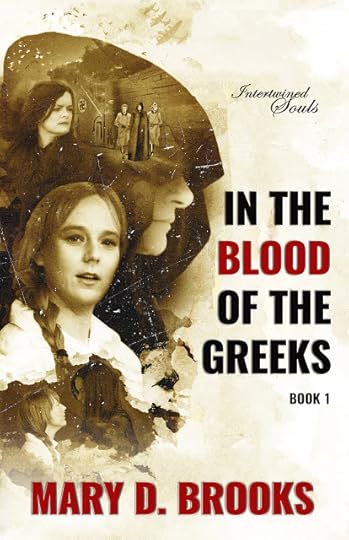
Forbidden love, heart racing suspense, an epic tale set in war-ravaged Greece.
Two women -- one a German officer's daughter, the other a young Greek woman filled with fury -- race against time to help Jews escape a Greek town during World War II. They are moments from death if their clandestine operation is exposed.
Eva and Zoe should be enemies but fate brings them together to work as a team to accomplish their life saving mission. They find themselves in an unlikely friendship that transcends the barriers between them and while they work to help Jews escape, their unlikely friendship turns to love. Zoe Lambros' faith in God is shattered after her mother's death at the hands of the German Commander. She determines to defy the enemy in every way she can--including a festering urge to kill the German Commander's daughter, Eva Muller.
Eva Muller has a tortured past, and a secret, if revealed, will lead to certain death at the hands of her father. Despite knowing the risk, Eva is working with the village priest to help the Jews escape. With her activities closely observed, Eva needs help to continue the clandestine operation and Zoe Lambros is the answer despite her antagonism to the fiery Greek.
Excerpt
Zoe and her mother Helena walked towards the field. As she looked around the small farming community, Zoe carefully watched her fellow countrymen assembling as they were instructed. They were subdued. Memories arose of balmy summer nights walking along with her friends, memories of carefree days when the worst that happened was a boy yanking her hair and being generally a nuisance.
Those boys were no longer there, no longer part of her life. Zoe felt her throat constrict and tried to swallow the lump in her throat but couldn’t. Tears threatened to spill but were kept back by sheer will. She didn’t want those German bastards to see her cry. She didn’t want to show any weakness. It was also the last thing she wanted for her mama to see. Too many nights were spent crying over the deaths of her brothers and her father. Zoe mentally shook herself and glanced at Helena, who was talking animatedly with her cousin.
Zoe’s attention shifted as a group of soldiers passed by. She wondered when the nightmare would end. To the Germans, the Greeks were a stubborn people who refused to surrender when all was lost. To the Greeks, the Germans were going to know that the country was not going to be subjugated without a struggle, without exacting a hefty price from the occupying force.
The town gathering had become a regular occurrence with the Italian commander. Major Busto was a sadistic man who took delight in torturing the populace. News of his death was met with muted joy—they knew another monster would take his place soon enough. They were right, and a demon had taken up Busto’s mantle for brutality if the stories everyone had been hearing were true.
They arrived at Maragos’ Field, which was now had acquired the unfortunate reputation as an execution field—it was where many innocent villagers had been murdered, and the soil was drenched in the blood of the Greeks. Zoe sighed and looked down at the brown sludgy mud under her feet.
Zoe glanced around her at familiar faces, faces that betrayed their fear. She saw old men and women barely being able to stand, huddled in the rain. The young children clasped their mothers’ hands. Some were too young to know what was to come. She felt sick as she glanced at her own mother, who had her eyes closed and was silently praying.
“I love you, Mama,” Zoe whispered. She took hold of Helena’s hand.
Helena opened her eyes and smiled. “I love you so much, my child. Have faith in God; we will be all right. Saint Achillius will protect us,” she said and leaned down and kissed the top of Zoe’s red-gold hair.
Giveaway
Mary D. Brooks is giving away 3 ebook copies ofIn The Blood Of The Greeks
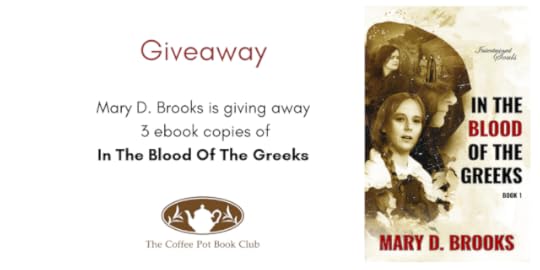
All you need to do is answer this question:
If you could meet any female resistance fighter, who would it be?
Leave your answer in the comments at the bottom of this post.
Giveaway Rules
• Leave your answer in the comments at the bottom of this post.• Giveaway ends at 11:59pm BST on June 5th.You must be 18 or older to enter.• Giveaway is only open Internationally.•Only one entry per household.• All giveaway entrants agree to be honest and not cheat the systems; any suspect of fraud is decided upon by blog/site owner and the sponsor, and entrants may be disqualified at our discretion.•Winners will be announced in the comments.• Winner has 48 hours to claim prize or new winner is chosen.
Pick up your copy ofIn The Blood Of The GreeksAmazon UK • Amazon US
Mary D. Brooks
I'm a wearer of many hats: author, graphic designer, artist, webmaster and assorted other creative hats. My passion is writing WW2 fiction and the aftermath. I was inspired to write about WW2 because of my adopted grandmother who was an Auschwitz survivor and my Greek grandfather who was in the Greek Resistance during WW2. They lit a fire in me when I was fourteen years old and it has never gone out; if we stop talking about it, people will forget. I'm also passionate about telling the story of the people history doesn't remember. Throw in some romance, a whole lot of history and a touch of urban fantasy.
Connect with Mary: Website• Twitter • Facebook • Instagram • Publisher.
Published on May 23, 2019 08:08
Are you looking for a safe and legitimate way to gain interest and reviews for your Book? Let's talk about #NetGalley #BookReviews #BooksGoSocial
[image error]
If so, NetGalley may be the answer.
What is NetGalley?
In their own words:
"NetGalley is a platform that allows publishers to put their books in front of readers of influence. Over 380,000 registered members use the site to find titles to review, books to stock in their stores or libraries, add to educational reading lists or cover in their media activities. If approved to access the title, members can download it securely to any major reading device, and as all files are protected, your content cannot be shared or disseminated. It’s the perfect way to amplify the interest in your titles before, during and after publication."
I have secured a massive 25% discount with Books Go Social's, already very reasonable, NetGalley Promotional Package. This discount makes it very affordable for you to get your book onto NetGalley and in front of those 380,000 registered members.
I would not try to sell you something that I did not believe in. I have used NetGalley, and it allowed me to connect with the most wonderful book bloggers, many of whom are now part of my launch team. For me, it was certainly worth the money.
NetGalley is the #1 service in the world for getting reviews on Amazon — many of the reviewers are Amazon Top Reviewers as well as being influential bloggers.
Who are Books Go Social?

Books Go Social (BGS) is a highly respected Author Promotion service — you may have already heard of them. The founder of BGS, Laurence O’ Bryan is dedicated to helping authors showcase their books. He knows what works and what does not. This is why I am so excited to be working with him on this fantastic deal.
This offer is only available for a very LIMITED TIME. With the 25% discount, this is one of the cheapest ways you can get your book in front of those influential NetGalley Professional Readers.
To get your 25% discount click on:
Books Go Social NetGalley Promotion
and type:
may25
at the checkout.
If you have any questions, then don’t hesitate to ask.
*NetGalley does not restrict to positive only reviews.
Published on May 23, 2019 00:26
May 22, 2019
#HistoricalFiction author, Christine Hancock, is taking a look at what life was like in the time of King Eadred #AnglosSaxon #giveaway @YoungByrhtnoth
Life in the time of King EadredBy Christine Hancock
When the Anglo-Saxons are mentioned, most people will know about King Alfred, at least that he burnt some cakes. Some will know a bit more, that he fought against the Danes. Thanks to the books written by Bernard Cornwell, and the television series, The Last Kingdom, based on them, some will now know a bit more; that he had a daughter, Aethelflaed, and a son, Edward. Those who have an interest in the period will also have heard of Aethelstan, Edward’s son, who became the first King of England.
But what about the rest of the family? Who came next? Did nothing happen in the next hundred plus years until 1066 and the Normans took over?
When Aethelstan died in AD939 he was in his mid-forties. He never married and had no children. Some experts say that since he was not a legitimate son of Edward he made a vow not to marry, so that there would be no competition for the “real” heirs of Edward. They were too young to rule after Edward’s death, especially as the war against the Danes had continued.
Edward had no surviving sons by his second wife Aelfflaed, so it was the son of the third, Eadgyfu, who became king after Aethelstan. Eadmund was only 18 when he came to the throne. He married quickly and his wife produced two sons. The future of the kingdom looked secure.
Despite the efforts of previous kings, the fight to take back the whole of England continued. The former kingdom of Northumbria, without an Anglo-Saxon king of its own since the invasion by the Great Heathen Army in the 860s, had become the target of every powerful man in search of a throne. Most of them were the children, or grandchildren of the original Viking invaders, some of whom had taken over Dublin and thought of York as part of the package.
Eadmund carried on the good work of his father and uncle, winning back swathes of the former Danelaw, took over Northumbria and even overran Cumbria (which he promptly gave to Malcolm of Scotland). All was going well, until he died, in a pointless brawl during a feast. He had been king for only seven years and left two sons, too young to rule. History was repeating itself.
 Eadred in the early fourteenth century Genealogical Roll of the Kings of England — Wikipedia.
Eadred in the early fourteenth century Genealogical Roll of the Kings of England — Wikipedia.Luckily, he had a brother, Eadred. King Eadred took the throne in 946. He continued his brother’s work and by the following year had signed a truce with the pretenders to the throne of York and Northumbria – which was immediately broken This time Erik Haraldsson claimed the throne.
Erik, better known as Bloodaxe, had been King of Norway from 931 to 933 and after being deposed by his younger brother Haakon the Good, his career is somewhat confused, but by 946 (or 7), after hanging around in Orkney he decided to try Northumbria.
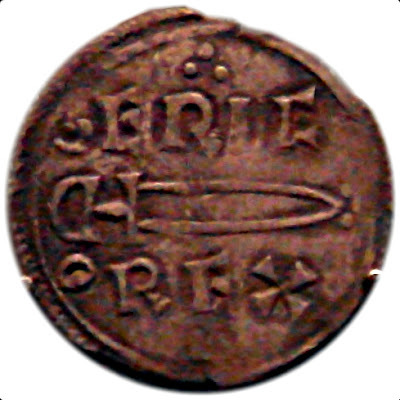 Coin of Eric Bloodaxe as King of York 952-954.
Coin of Eric Bloodaxe as King of York 952-954.King Eadred spent the rest of his short reign battling for Northumbria against Erik (twice – he tried to return in 952!) and the kings of Dublin. He suffered from ill health – possibly the same complaint suffered by his grandfather, King Alfred. The biographer of St Dunstan, described how “the king sucked out the juices of his food, chewed on what was left and spat it out”. King Eared died on 23 Nov 955, at the age of 32, He never married and left no known children.
He was succeeded by his nephew, Eadwig, the eldest son of Eadmund. Eadwig just 15, was legally an adult, but was not popular and conflict broke out between him and his brother Edgar. For a while Edgar ruled Mercia and Northumbria while Eadwig ruled in the south. Eadwig ruled for less than four years before his death and Edgar took over the whole country. He later became known as Edgar the Peaceable.
For a period that is barely mentioned in most history books there was a lot going on and some colourful personalities Apart from Erik Bloodaxe, there was St Dunstan.
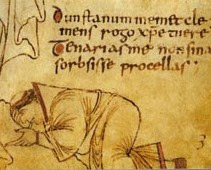 Possible self-portrait of Dunstan. Detail from the Glastonbury Classbook.
Possible self-portrait of Dunstan. Detail from the Glastonbury Classbook. When Eadmund came to the throne, Dunstan was an ordinary monk at Glastonbury. King Eadmund made him a minister and Abbot of Glastonbury. He started the reform of monastic life in England. When Eadred became king, Dunstan was by his side, twice refusing the office of bishop. Things changed when Eadwig came to the throne and Dunstan was exiled, returning only when recalled by Edgar.
When I decided to write about the early life of Byrhtnoth, I thought I would have a problem with the plot; surely nothing much was happening in that period of kings with strange, forgotten names. Instead, I found a time of sudden death and shifting alliances. It is no straightforward story like King Alfred’s fight against the Danes, but a time when who you knew, or who you were related to could sometimes be a matter of life and death.
How did my protagonist survive into his sixties only to be killed by Vikings at the Battle of Maldon in AD 991? By keeping his head down, or being a member of, or marrying into, the right family?
Byrhtnoth married the sister of King Edmund’s second wife, stepmother of King Edgar. It seems he knew how to pick the right side. Did he learn how to do it during the short reign of King Eadred?
Bright AxeBook #2 in the Byrhtnoth Chronicles series

AD 947: Byrhtnoth has received his father’s sword. But his hall is burnt and the sword stolen. Learning that his father still lives, he swears a solemn vow to find him.
Torn between his quest and duty to Lord Athelstan of East Anglia, friends are hurt when an old enemy unexpectedly reappears. Despised by his best friend for his failure, he is sent deep into Northumbria, to Bebbanburg.
Winter closes in and wolves prowl the hills. Who is the mysterious woman he encounters there? She offers him news of his father – and more.
Will Byrhtnoth remain with her, or return home to discover the fate of the friends he abandoned?
Or should he continue the quest for his father?
Excerpt
Excerpt from Bright Axe (Byrhtnoth meets Bloodaxe)
The entrance to the bridge was narrow, and we blocked access. The second row of shields had assembled behind us, with plenty of throwing spears. We were a serious obstacle. Many men would die. We waited for the attack. They stood quiet, bar the occasional insult, which we ignored.
We heard shouts, cheers, coming closer. We saw grins appear on the faces of the men opposite. My mouth was dry. Where was the skin of ale? I needed it to moisten my throat, and for the courage it would bring. No, a clear head was better. Sweat dripped down my face. I licked my lips, it was liquid, though it would make me thirsty. I swallowed.
Something tall moved through the trees, a monster half visible through the leaves. When it emerged into the bright sunlight, it was just a man on a horse, but what a man, and what a horse. Hooves the size of platters sent vibrations through the ground. I stared straight into a whiskered mouth. A lip curled and strings of drool dangled from long yellow teeth. The great head dropped, to reveal the rider.
"Bloodaxe." Leif spat the name with venom. The man stopped and stared at us.
Big as the horse was, it must have struggled to carry this man. It was difficult to tell his height, a match for mine, or taller? Legs like tree trunks gripped the horse's sides. His body slumped in a saddle large enough for two normal men. The links of his byrnie strained to contain the bulging body, His face was red and streamed with sweat. Grey hair hung from beneath a richly decorated, though battered helmet. It matched the beard that lay like a dead badger on his broad chest.
The axe that hung beside him was indeed red though not from blood. It was painted scarlet, and the blade was dull, a weapon for display, not use.
He spoke. His voice was loud and harsh. It would have once rung loud and commanding across the field of battle. Although age had dulled it, he still expected men to quake before him. We stood our ground.
"He's telling us to get out of the way," Leif translated.
"I got the gist," I replied.
Another man had joined him, hoisting a banner over his master's head."Erik Haraldsson, King of Norway and Northumbria, commands that you clear the road."
I stood silent for a moment, before giving my reply.
"I am afraid I cannot do that." To my surprise, my voice sounded clear. I ignored the servant and addressed Earl Erik. "I have heard of you, my lord. You were a great warrior, King of Norway, many years ago."
"Careful," hissed Leif. I ignored him.
"You claim to be King of Northumbria. May I respectfully remind you; Northumbria is that way." I pointed over my shoulder. "And I am here to stop you."
"Who are you?" So, he did speak our language.
"I am Thegn Byrhtnoth, of the East Anglian Ship Fyrd. I serve Ealdorman Athelstan. And Eadred, king of all England."
"You are a long way from the sea."
"So are you and I have burned your ships."
The standard bearer pointed towards the smouldering wrecks. Erik peered in that direction. How good was his eyesight? How old was he now, close to sixty? He nodded and hauled on his reins. His horse woke from its doze. Erik rumbled some words in my direction. He laughed and kicked the animal back the way he had come.
"My Lord Erik will discuss this matter with your king." The standard bearer opened his mouth to say more, had second thoughts and followed his master. The enemy shield wall broke up and trailed after them.
"What did he actually say?" I asked Leif as we stood and watched them go.
"He requested that if Gunnhild, that's his wife, tried to cross the bridge, you should stop her in the same manner. He left her in York.""I'll do my best." I forced a laugh and tried to relax.
Giveaway
Christine Hancock is giving away one signed paperback copy of her fabulous book
Bright Sword
Book #1 in the Byrhtnoth Chronicles series.

All you need to do is answer this question:
Which historical character do you think has been unfairly neglected?
Giveaway Rules
• Leave your answer in the comments at the bottom of this post.
• Giveaway ends at 11:59pm BST on June 6th.
You must be 18 or older to enter.
• Giveaway is only open UK Residents Only.
•Only one entry per household.
• All giveaway entrants agree to be honest and not cheat the systems; any suspect of fraud is decided upon by blog/site owner and the sponsor, and entrants may be disqualified at our discretion.
•Winners will be announced in the comments.
• Winner has 48 hours to claim prize or new winner is chosen.
Pick up your copy ofBright SwordAmazon UK • Amazon US
Christine Hancock
 I was born in Essex and moved to Rugby, Warwickshire when I married. I have a husband, two sons and two lovely grandchildren.
I was born in Essex and moved to Rugby, Warwickshire when I married. I have a husband, two sons and two lovely grandchildren.I am a long-term family historian, leader of the local history group and town guide.
I had never thought of becoming an author – I just wanted to write about some of my ancestors. In 2013 I joined a writing class. The class turned out to be about writing fiction. Before I knew it, I was writing a novel.
Byrhtnoth was a real warrior who died in the 991 Battle of Maldon, made famous by the Anglo-Saxon poem of that name. Growing up in Essex, I visited Maldon often, and attended the 1000 year anniversary of the battle in 1991.I wanted to find out what made Byrhtnoth such a famous warrior.
I finished the book but found it had become a series – how long, I have yet to find out.
Connect with Christine: Blog • Facebook • Twitter
Published on May 22, 2019 23:00
May 21, 2019
Have you heard? #HistoricalFiction author, Linda Bennett Pennell, is giving away a signed set of her fabulous books — Al Capone at the Blanche Hotel & Miami Days, Havana Nights! #Giveaway @LindaPennell @hfvbt
Historical Fiction Virtual Blog Tours Presents…
Al Capone at the Blanche HotelBy Linda Bennett Pennell

Al Capone at the Blanche Hotel tells a story of lives unfolding in different centuries, but linked and irrevocably altered by a series of murders in 1930.
Lake City, Florida, June, 1930: Al Capone checks in for an unusually long stay at the Blanche Hotel, a nice enough joint for an insignificant little whistle stop. The following night, young Jack Blevins witnesses a body being dumped heralding the summer of violence to come. One-by-one, people controlling county vice activities swing from KKK ropes. No moonshine distributor, gaming operator, or brothel madam, black or white, is safe from the Klan’s self-righteous vigilantism. Jack’s older sister Meg, a waitress at the Blanche, and her fiancé, a sheriff’s deputy, discover reasons to believe the lynchings are cover for a much larger ambition than simply ridding the county of vice. Someone, possibly backed by Capone, has secret plans for filling the voids created by the killings. But as the body count grows and crosses burn, they come to realize this knowledge may get all of them killed.
Gainesville, Florida, August, 2011: Liz Reams, an up and coming young academic specializing in the history of American crime, impulsively moves across the continent to follow a man who convinces her of his devotion yet refuses to say the three simple words I love you. Despite the entreaties of friends and family, she is attracted to edginess and a certain type of glamour in her men, both living and historical. Her personal life is an emotional roller coaster, but her career options suddenly blossom beyond all expectation, creating a very different type of stress. To deal with it all, Liz loses herself in her professional passion, original research into the life and times of her favorite bad boy, Al Capone. What she discovers about 1930’s summer of violence, and herself in the process, leaves her reeling at first and then changed forever.
Praise for Al Capone at the Blanche Hotel5 Star Top Pick “…brilliantly written…” BTSemagazine
“…The characters were so well done that I latched onto them and wanted to know where their journey was going to end up. It’s a fascinating read. The way the author wrote this story made it so easy to get a visual of the characters, the setting and just life in general – you could feel yourself in the ’30′s, living what they were living and you could feel yourself in the present time, living what Liz was living. I highly recommend it.”
Maggie Thom, The Write to Read
Excerpt
Saturday June 14, 1930 O’Leno, Florida
Jack jammed a finger into each ear and swallowed hard. Any other time, he wouldn’t even notice the stupid sound. The river always sorta slurped just before it pulled stuff underground.
His stomach heaved again. Maybe he shouldn’t look either, but he couldn’t tear his eyes away from the circling current. When the head slipped under the water, the toe end lifted up. Slowly the tarpaulin wrapped body, at least that’s what it sure looked like, went completely vertical. It bobbed around a few times and finally gurgled its way down the sinkhole. Then everything went quiet . . . peaceful . . . crazily normal. Crickets sawed away again. An ole granddaddy bullfrog croaked his lonesomeness into the sultry midnight air.
Crouched in the shelter of a large palmetto clump, Jack’s muscles quivered and sweat rolled into his eyes, but he remained stock-still. His heart hammered like he had just finished the fifty yard dash, but that was nothing to what Zeke was probably feeling. He was still just a little kid in lots of ways.
When creeping damp warmed the soles of Jack’s bare feet, he grimaced and glanced sideways. Zeke looked back with eyes the size of saucers and mouthed the words I’m sorry. Jack shook his head then wrinkled his nose as the odor of ammonia and damp earth drifted up. He’d always heard that fear produced its own peculiar odor, but nobody ever said how close you had to be to actually smell it. He prayed you had to be real close; otherwise, he and Zeke were in big trouble.
The stranger standing on the riverbank stared out over the water for so long Jack wondered if the man thought the body might suddenly come flying up out of the sinkhole and float back upriver against the current. Funny, the things that popped into your head when you were scared witless.
The man removed a rag from his pocket and mopped his face. He paused, looked upstream, then turned and stared into the surrounding forest. As his gaze swept over their hiding place, Jack held his breath and prayed, but he could feel Zeke’s chest rising and falling in ragged jerks so he slipped his hand onto Zeke’s arm. Under the gentle pressure of Jack’s fingers, Zeke’s muscles trembled and jumped beneath his soft ebony skin. When Zeke licked his lips and parted them like he was about to yell out, Jack clapped a hand over the open mouth and wrapped his other arm around Zeke’s upper body, pulling him close and holding him tight. Zeke’s heart pounded against the bib of his overalls like it might jump clean out of his chest.
With one final look ‘round at the river and forest, the stranger strode to the hand crank of a Model T. The engine caught momentarily, then spluttered and died. A stream of profanity split the quiet night. The crank handle jerked from its shaft and slammed back into place. More grinding and more swearing followed until the thing finally coughed to life for good and a car door slammed. Only then did Jack relax his hold on Zeke.
“I want outta here. I wanna go home,” Zeke whispered hoarsely.
Lucky Zeke. Before Meg left home to move into town, Jack would have felt the same way. Now he didn’t care if he ever went home.
Jack cocked an ear in the Ford’s direction. “Hush so I can listen. I think he’s gone, but we’re gonna belly crawl in the opposite direction just to be sure we ain’t seen.”
“Through that briar patch? I ain’t got on no shoes or shirt.”
“Me neither. Come on. Don’t be such a baby.”
“I ain’t no baby,” Zeke hissed as he scrambled after Jack.
When the pine forest thinned out, Jack raised up on his knees for a look around. Without a word, Zeke jumped to his feet and started toward the road. Jack grabbed a strap on Zeke’s overalls and snatched him back onto his bottom.
“You taken complete leave of your senses?” Wiping sweat out of his eyes, Jack pushed his shaggy blonde hair to one side. “Check it out before you go bustin’ into the open.”
“Why you so bossy all the time? I ain’t stupid, ya know. Just cause you turned twelve don’t make you all growed up.”
Zeke’s lower lip stuck out, trembling a little. Whether it was from fear or anger, Jack wasn’t sure. Probably both. Peering into the night, he strained for the flash of headlights. Nothing but bright moonlight illuminated the road’s deep white sand. Finally confident that no vehicles were abroad, he grabbed Zeke’s hand and pulled him to his feet. With one final glance left, then right, they leapt onto the single lane track and ran like the devil was on their tails.
Pick up your copy ofAl Capone at the Blanche HotelAmazon UK • Amazon US
Miami Days, Havana NightBy Linda Bennett Pennell

Sometimes our biggest debts have nothing to do with money.
1926. When seventeen-year-old Sam Ackerman witnesses a mob hit, he is hustled out of New York under the protection of Moshe Toblinsky, A.K.A., the mob’s bookkeeper. Arriving in Miami with no money, no friends, and no place to hide, Sam’s only choice is to do as the gangster demands. Forced into bootlegging, Sam’s misery is compounded when he falls in love. Amazingly, the beautiful, devout Rebecca wants only him, but he cannot give her the life she deserves. When Prohibition ends, Sam begs the mobster to set him free. The price? A debt, as Toblinsky puts it, of friendship. A debt that will one day come due.
Present Day. History of American Crime professor Liz Reams has it all—early success, a tantalizing lead on new info about Moshe Toblinsky, and a wonderful man to love. Life is perfect. So what’s keeping her from accepting her guy’s marriage proposals? Confronting a long-standing personal debt sets her on a journey of self-discovery. While she delves ever deeper into Sam’s and Toblinsky’s relationship, her understanding of her own relationships increases as well, but the revelations come at a price. The emotional and physical dangers of her dual journeys may prove too big to handle.
Pick up your copy ofMiami Days, Havana NightsAmazon UK • Amazon US
Giveaway
During the Blog Tour, we will be giving away a signed set of Al Capone at the Blanche Hotel & Miami Days, Havana Nights! You can enter HERE!
Giveaway Rules
• Giveaway ends at 11:59 pm EST on May 22nd. You must be 18 or older to enter.
• Giveaway is open to US only.
• Only one entry per household.
• All giveaway entrants agree to be honest and not cheat the systems; any suspicion of fraud is decided upon by blog/site owner and the sponsor, and entrants may be disqualified at our discretion.
• The winner has 48 hours to claim prize or new winner is chosen.
Linda Bennett Pennell
 I have been in love with the past for as long as I can remember. Anything with a history, whether shabby or majestic, recent or ancient, instantly draws me in. I suppose it comes from being part of a large extended family that spanned several generations. Long summer afternoons on my grandmother’s porch or winter evenings gathered around her fireplace were filled with stories both entertaining and poignant. Of course being set in the South, those stories were also peopled by some very interesting characters, some of whom have found their way into my work.As for my venture in writing, it has allowed me to reinvent myself. We humans are truly multifaceted creatures, but unfortunately we tend to sort and categorize each other into neat, easily understood packages that rarely reveal the whole person. Perhaps you, too, want to step out of the box in which you find yourself. I encourage you to look at the possibilities and imagine. Be filled with childlike wonder in your mental wanderings. Envision what might be, not simply what is. Let us never forget, all good fiction begins when someone says to herself or himself, “Let’s pretend.”
I have been in love with the past for as long as I can remember. Anything with a history, whether shabby or majestic, recent or ancient, instantly draws me in. I suppose it comes from being part of a large extended family that spanned several generations. Long summer afternoons on my grandmother’s porch or winter evenings gathered around her fireplace were filled with stories both entertaining and poignant. Of course being set in the South, those stories were also peopled by some very interesting characters, some of whom have found their way into my work.As for my venture in writing, it has allowed me to reinvent myself. We humans are truly multifaceted creatures, but unfortunately we tend to sort and categorize each other into neat, easily understood packages that rarely reveal the whole person. Perhaps you, too, want to step out of the box in which you find yourself. I encourage you to look at the possibilities and imagine. Be filled with childlike wonder in your mental wanderings. Envision what might be, not simply what is. Let us never forget, all good fiction begins when someone says to herself or himself, “Let’s pretend.”I currently reside in the Houston area with my sweet husband and a German Shorthaired Pointer who thinks she’s a little girl.
Connect with Linda:
WEBSITE • BLOG • FACEBOOK • TWITTER • GOODREADS • AMAZON

Published on May 21, 2019 22:30
May 20, 2019
Have you heard? #HistoricalFiction author, Susanne Dunlap, is giving away one copy of her fabulous book — Listen to the Wind #Giveaway @Susanne_Dunlap @hfvbt
Historical Fiction Virtual Blog Tours Presents…
Listen to the WindBy Susanne Dunlap

Sent away from their families for their own protection when they were very young, Azemar and Azalaïs become separated when they are forced to flee from the band of outlaws who served as their supposed protectors. Armed only with scraps of memories and the wits and intelligence that have helped them survive brutal conditions, they struggle to find each other again and discover the mysterious past that links them across distance and time. Who are they? And do they hold the secret of the legendary Cathar treasure? All they know is that knights and monks spell danger, and they must find a way to survive at all costs if they are to fulfill their destiny—and preserve their vanishing culture.
Giveaway
During the Blog Tour, we will be giving away one copy of Listen to the Wind by Susanne Dunlap! Enter, HERE!Giveaway Rules
• Giveaway ends at 11:59 pm EST on May 28th. You must be 18 or older to enter.
• Giveaway is open INTERNATIONALLY.
• Only one entry per household.
• All giveaway entrants agree to be honest and not cheat the systems; any suspicion of fraud is decided upon by blog/site owner and the sponsor, and entrants may be disqualified at our discretion.• The winner has 48 hours to claim prize or new winner is chosen.
Pick up your copy of
Listen to the WindAMAZON • BARNES AND NOBLE • INDIEBOUND • KOBO
Susanne Dunlap
 Susanne Dunlap is the author of six works of historical fiction. Two are for adults (Emilie’s Voice and Liszt’s Kiss, both published by Touchstone books of Simon & Schuster). Four are for young adults (The Musician’s Daughter, Anastasia’s Secret, In the Shadow of the Lamp, and The Academie, published by Bloomsbury). A graduate of Smith College with a PhD in Music History from Yale University, Susanne grew up in Buffalo, New York and has lived in London, Brooklyn and Northampton, MA. She now lives in Northampton with her long-time partner, Charles, has two grown daughters, three granddaughters, a grandson, a stepson and a stepdaughter, four step-grandsons and one step-granddaughter—that’s a total of four children and nine grandchildren!In her spare time she cycles in the beautiful Pioneer Valley.For more information, please visit The Orphans of Tolosa website. You can follow author Susanne Dunlap on Facebook, Twitter, Goodreads, Instagram, Pinterest, and BookBub.
Susanne Dunlap is the author of six works of historical fiction. Two are for adults (Emilie’s Voice and Liszt’s Kiss, both published by Touchstone books of Simon & Schuster). Four are for young adults (The Musician’s Daughter, Anastasia’s Secret, In the Shadow of the Lamp, and The Academie, published by Bloomsbury). A graduate of Smith College with a PhD in Music History from Yale University, Susanne grew up in Buffalo, New York and has lived in London, Brooklyn and Northampton, MA. She now lives in Northampton with her long-time partner, Charles, has two grown daughters, three granddaughters, a grandson, a stepson and a stepdaughter, four step-grandsons and one step-granddaughter—that’s a total of four children and nine grandchildren!In her spare time she cycles in the beautiful Pioneer Valley.For more information, please visit The Orphans of Tolosa website. You can follow author Susanne Dunlap on Facebook, Twitter, Goodreads, Instagram, Pinterest, and BookBub.
Published on May 20, 2019 23:00
Have you heard? #HistoricalFiction author, Susanne Dunlop, is giving away one copy of her fabulous book — Listen to the Wind #Giveaway @Susanne_Dunlap @hfvbt
Historical Fiction Virtual Blog Tours Presents…
Listen to the WindBy Susanne Dunlop

Sent away from their families for their own protection when they were very young, Azemar and Azalaïs become separated when they are forced to flee from the band of outlaws who served as their supposed protectors. Armed only with scraps of memories and the wits and intelligence that have helped them survive brutal conditions, they struggle to find each other again and discover the mysterious past that links them across distance and time. Who are they? And do they hold the secret of the legendary Cathar treasure? All they know is that knights and monks spell danger, and they must find a way to survive at all costs if they are to fulfill their destiny—and preserve their vanishing culture.
Giveaway
During the Blog Tour, we will be giving away one copy of Listen to the Wind by Susanne Dunlap! Enter, HERE!Giveaway Rules
• Giveaway ends at 11:59 pm EST on May 28th. You must be 18 or older to enter.
• Giveaway is open INTERNATIONALLY.
• Only one entry per household.• All giveaway entrants agree to be honest and not cheat the systems; any suspicion of fraud is decided upon by blog/site owner and the sponsor, and entrants may be disqualified at our discretion.• The winner has 48 hours to claim prize or new winner is chosen.
Pick up your copy of
Listen to the WindAMAZON • BARNES AND NOBLE • INDIEBOUND • KOBO
Susanne Dunlap
 Susanne Dunlap is the author of six works of historical fiction. Two are for adults (Emilie’s Voice and Liszt’s Kiss, both published by Touchstone books of Simon & Schuster). Four are for young adults (The Musician’s Daughter, Anastasia’s Secret, In the Shadow of the Lamp, and The Academie, published by Bloomsbury). A graduate of Smith College with a PhD in Music History from Yale University, Susanne grew up in Buffalo, New York and has lived in London, Brooklyn and Northampton, MA. She now lives in Northampton with her long-time partner, Charles, has two grown daughters, three granddaughters, a grandson, a stepson and a stepdaughter, four step-grandsons and one step-granddaughter—that’s a total of four children and nine grandchildren!In her spare time she cycles in the beautiful Pioneer Valley.For more information, please visit The Orphans of Tolosa website. You can follow author Susanne Dunlap on Facebook, Twitter, Goodreads, Instagram, Pinterest, and BookBub.
Susanne Dunlap is the author of six works of historical fiction. Two are for adults (Emilie’s Voice and Liszt’s Kiss, both published by Touchstone books of Simon & Schuster). Four are for young adults (The Musician’s Daughter, Anastasia’s Secret, In the Shadow of the Lamp, and The Academie, published by Bloomsbury). A graduate of Smith College with a PhD in Music History from Yale University, Susanne grew up in Buffalo, New York and has lived in London, Brooklyn and Northampton, MA. She now lives in Northampton with her long-time partner, Charles, has two grown daughters, three granddaughters, a grandson, a stepson and a stepdaughter, four step-grandsons and one step-granddaughter—that’s a total of four children and nine grandchildren!In her spare time she cycles in the beautiful Pioneer Valley.For more information, please visit The Orphans of Tolosa website. You can follow author Susanne Dunlap on Facebook, Twitter, Goodreads, Instagram, Pinterest, and BookBub.
Published on May 20, 2019 23:00
Join Historical Fiction author, Chrystyna Lucyk-Berger, as she takes a look at how How Woodrow Wilson’s Fourteen Points Failed Tyrol #History #WW1 @ckalyna
How Woodrow Wilson’s Fourteen Points Failed Tyrol.By Chrystyna Lucyk-Berger
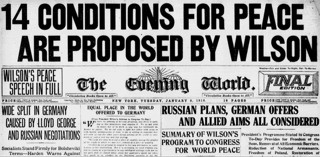
Imagine driving south, over the Austrian border into northern Italy. You start to run through your rudimentary Italian, and as you cross the Reschen Pass—still a German name—you encounter the first pizzeria on the side of the road and think, “Yeah, baby! We’re in Italy!”
Other than the little bit of Italian signage, not much has changed, yet. It still looks like Tyrol: mountains, fields, a bubbling creek, the alpine architecture. Right next to the pizzeria is a Speck and Äpfel stand. Because you’ve been in Austria for at least a day, you already know that these are the signs for that incredible smoked bacon and those delicious apples used in the last guesthouse’s Strudel.
 At first, you might consider that some Tyroleans migrated over the border, maintained their “brand” and wrote their signs in German. Except, that’s not it. The first town you encounter, Reschen also has another name: Rescia. Graun—the sign indicates—is also called Curon Venosta. The valley itself is both called Obervinschgau and Val Venosta. And then, coming over a small hill, you gasp. Where once there was fertile farmland, now a beautiful 4-mile-long reservoir, nestled in the Alpine peaks, stretches to the southern horizon. You slow down because something else has caught your attention and everyone on the road is pulling off to the right. You follow them because you can’t believe what you’re looking at. About 200 yards from the eastern shore, and rising out of the water, is a medieval church tower, fully intact. And you ask, “What the hell happened?”
At first, you might consider that some Tyroleans migrated over the border, maintained their “brand” and wrote their signs in German. Except, that’s not it. The first town you encounter, Reschen also has another name: Rescia. Graun—the sign indicates—is also called Curon Venosta. The valley itself is both called Obervinschgau and Val Venosta. And then, coming over a small hill, you gasp. Where once there was fertile farmland, now a beautiful 4-mile-long reservoir, nestled in the Alpine peaks, stretches to the southern horizon. You slow down because something else has caught your attention and everyone on the road is pulling off to the right. You follow them because you can’t believe what you’re looking at. About 200 yards from the eastern shore, and rising out of the water, is a medieval church tower, fully intact. And you ask, “What the hell happened?”Step into the time machine, dear reader. Let’s go back to just before the outbreak of World War 1 and illustrate the situation: the Austro-Hungarian Empire had its reach into a good part of today’s northern Italy, all the way to the Po Valley and Trentino. A good majority of that land also belonged to the autonomous province of Tyrol, who had earned its hard-won freedom after the Napoleonic Wars. However, in Italy, a large group of disgruntled nationalists held to the belief that the lands to the Brenner Frontier (if you Google this, look just south of Innsbruck) were traditionally Italian. Of course they should have been—that line of mountains was a wonderful natural barrier against potential enemies to the north.
The thing is, Italy and the Austro-Hungarian Empire had little conflict with one another. And in the Tyrolean province, Italian migrants were generally welcomed with open arms. They worked there, lived there, filled in the jobs that needed filling, especially in agricultural labour. All in all, these two cultures worked pretty well together, as well as with the Slavs to the east among a handful of other “regulars”.
So, what happened? It’s called the Treaty of London. Signed in 1915, the Triple Entente promised huge swaths of land to these Italian nationalists if Italy took up arms against its neighbours and Germany. And there you go. Now imagine Giuseppe and his family work on your Tyrolean farm. He’s called to service. He has to cross the line to the south, pick up his weapon, turn around and face his employer in a war where not one single Italian unit ever crossed into Tyrol. Not one. The battles were all fought south of the line.
Enter the good ol’ U-S-of-A. And the end of the war, President Woodrow Wilson’s Fourteen Points, specifically 9-11:
“IX. A readjustment of the frontiers of Italy should be effected along clearly recognizable lines of nationality.“X. The people of Austria-Hungary, whose place among the nations we wish to see safeguarded and assured, should be accorded the freest opportunity to autonomous development.“XI. Romania, Serbia, and Montenegro should be evacuated; occupied territories restored; Serbia accorded free and secure access to the sea; and the relations of the several Balkan states to one another determined by friendly counsel along historically established lines of allegiance and nationality...”
All very well and good, right? Noble. Righteous. Principally sound, especially if you’re an American. All three of these were contentious matters.
Imagine you’re Wilson and the French, the Russians and the British pull you aside at tea and say, “Emmm, Sir? With all due respect, we’re going to have to ignore those points in the case of Tyrol, south of the Brenner Frontier” as well as the Balkans—like Trieste, for example—because there was…well…a secret treaty.
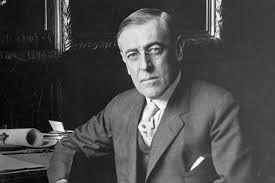 Woodrow Wilson
Woodrow WilsonWilson was not prepared to budge on this, so Italy’s prime minister, Vittorio Orlando, arrived with his delegation and debated how the Brenner Frontier was absolutely Italian. He rolled out some maps and pointed out that this was naturally true. The rivers, look! They flowed from the south to the north.
Nobody checked to see whether they really did. And they didn’t. The Italians had fudged the maps.
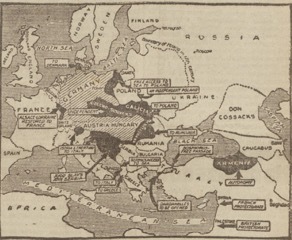
Very simply put, Wilson was in a pickle. Italy was granted the new frontier and the Tyroleans were faced with a cultural pogrom not unlike Stalin’s over Ukraine: the German language and culture were systematically eradicated between 1918 and into World War 2, with Hitler and Mussolini even creating a pact and demanding the Tyroleans choose either to be Italian or German citizens. Those who voted German, were relocated to new territories within the Third Reich. Those who chose Italian, were threatened with relocation to the colonies in Abyssinia. Either way, they were about to all be displaced. If World War 2 had not broken out, who knows how things would have turned out? But when Hitler marched onto Poland, the whole program came to a halt.
But what of this church tower? What happened at this lake on the Reschen Pass?
The Austro-Hungarian Empire had laws in place, which dictated that no man-made structure could be built if it affected over a certain percentage of the locals’ livelihoods. Those laws protected the Obervinschgau Valley from a proposal to raise the lakes of Reschen and Graun by five meters for the purposes of producing electricity. The plan was reneged. Dead in the water, so to speak, before it could find its legs because it would have affected too much of the fertile farmland in the valley.
But Italy suffered in World War I. They had barely managed to hang onto their britches and one of the first things that occurred was a very strong force that swore that would never happen again. Enter stage right: Benito Mussolini. Italy was in chaos, and after wresting control from the monarchy he laid out a plan to make Italy the strongest industrial nation in Europe. The race with America began.
In order to build machines and technology, you need power. You need electricity. And the new territory of the Alto Adige / Südtirol, or South Tyrol, had a treasure trove of areas for reservoirs and dams. But how do you get around those old laws?
Very simply. You write new ones.
The Reschensee / Lago di Rescia is just one of perhaps a thousand stories about the misdeeds enacted against the German-speaking Tyroleans but the way this particular reservoir was built reads like a thriller. Corruption, greed, and prejudice were the key cornerstones in making this beautiful reservoir possible. Beneath the surface, lie seven villages, wholly and completely destroyed and a history of families who were ripped from their homes.
Have you ever heard of this? I hadn’t. My history lessons in school taught me only how important Wilson’s Fourteen Points were to bringing stability to Europe after WW1. We were taught how noble, how righteous, how just they were. Yet, “Wilson himself would later admit that he conceded the territory based on ‘insufficient study’ and that he came to regret this ‘ignorant’ decision.” (Scott A. Berg, Wilson)
Discovering the plight of the Tyroleans to the south of the Brenner really got under my skin. The more I dug into the history, the more I could understand why there is—to this day—a film of discontent, of bitterness that lies just beneath the surface, still hot to the touch. Tyrol regained its autonomy in an agreement negotiated between Austria and Italy in 1946. Its last measures took effect in this century.
Isn’t it interesting how, when you dig beneath the surface, you uncover the reality and complexity involved in political relationships? Isn’t it interesting how, when you look beneath the surface, you can begin to calculate the differences between intentions and actions? For the purposes of diplomacy, they often lead to inactions.
The Reschen Valley:Season 1 - 1920-1924 - Box SetBy Chrystyna Lucyk-Berger

She wants her home. He wants control. The Fascists want both.1920. Former Austrian Tyrol.When Katharina Thaler, a young Tyrolean farmer, finds a wounded Italian engineer in the mountains of the Reschen Valley, her decision to save his life thrusts both of them into a labyrinth of corruption, prejudice and greed.Angelo Grimani, a civil engineer, knows the details of a project that may destroy Katharina’s valley. Not in favour of it himself, he returns home to fend off the forces that envision the biggest reservoir in Italy, headed by Angelo’s own father.As the Tyroleans gear themselves to fight for their land, the Fascist party gathers power and momentum. Katharina and Angelo must each decide what to protect: love or country?Dive in and discover the gripping saga based on a history you never knew. This box set contains the first three of six books: No Man’s Land: Part 1, The Breach: Part 2, The Smuggler of Reschen Pass: The Prequel and bonus material including, From Jutta’s Kitchen: 12 South Tyrolean Recipes to bring the Reschen Valley series closer to home.
Pick up your copy of
The Reschen Valley:Season 1 - 1920-1924 - Box Set
Only 2.99* on Kindle for a Limited Time.Amazon UK • Amazon US • Books2Read
*The price may vary in some markets

Chrystyna Lucyk-Berger
 Chrystyna Lucyk-Berger is an American author living in Austria. Her focus is on historical fiction now. She has been a managing editor for a publishing house, has worked as an editor, and has won several awards for her travel narrative, flash fiction and short stories. She lives with her husband in a “Grizzly Adams” hut in the Alps, just as she’d always dreamed she would when she was a child.
Chrystyna Lucyk-Berger is an American author living in Austria. Her focus is on historical fiction now. She has been a managing editor for a publishing house, has worked as an editor, and has won several awards for her travel narrative, flash fiction and short stories. She lives with her husband in a “Grizzly Adams” hut in the Alps, just as she’d always dreamed she would when she was a child.Connect with Chrystyna: Website • Facebook • Twitter.
Published on May 20, 2019 06:20
May 19, 2019
#BookReview — No Woman's Land: A Holocaust Novel By Ellie Midwood #HistoricalFiction #WW2
Ellie Midwood
 Ellie Midwood is an award-winning, best-selling historical fiction writer. She's a health-obsessed yoga enthusiast, a neat freak, an adventurer, Nazi Germany history expert, polyglot, philosopher, a proud Jew, and a doggie mama.
Ellie Midwood is an award-winning, best-selling historical fiction writer. She's a health-obsessed yoga enthusiast, a neat freak, an adventurer, Nazi Germany history expert, polyglot, philosopher, a proud Jew, and a doggie mama.Ellie lives in New York with her fiancé and their Chihuahua named Shark Bait.
Awards:
Readers' Favorite - winner in the Historical fiction category (2016) - "The Girl from Berlin: Standartenführer's Wife"
Readers' Favorite - winner in the Historical fiction category (2016) - "The Austrian"(honorable mention)
New Apple - 2016 Award for Excellence in Independent Publishing - "The Austrian"(official selection)
Readers' Favorite - winner in the Historical fiction category (2017) - "Emilia"
Readers' Favorite - winner in the Historical fiction category (2018) - "A Motherland's Daughter, A Fatherland's Son"
Connect with Ellie:
Website • Amazon • Goodreads • BookBub • Facebook.
Published on May 19, 2019 22:30
The Coffee Pot Book Club
The Coffee Pot Book Club (formally Myths, Legends, Books, and Coffee Pots) was founded in 2015. Our goal was to create a platform that would help Historical Fiction, Historical Romance and Historical
The Coffee Pot Book Club (formally Myths, Legends, Books, and Coffee Pots) was founded in 2015. Our goal was to create a platform that would help Historical Fiction, Historical Romance and Historical Fantasy authors promote their books and find that sometimes elusive audience. The Coffee Pot Book Club soon became the place for readers to meet new authors (both traditionally published and independently) and discover their fabulous books.
...more
...more
- Mary Anne Yarde's profile
- 159 followers



